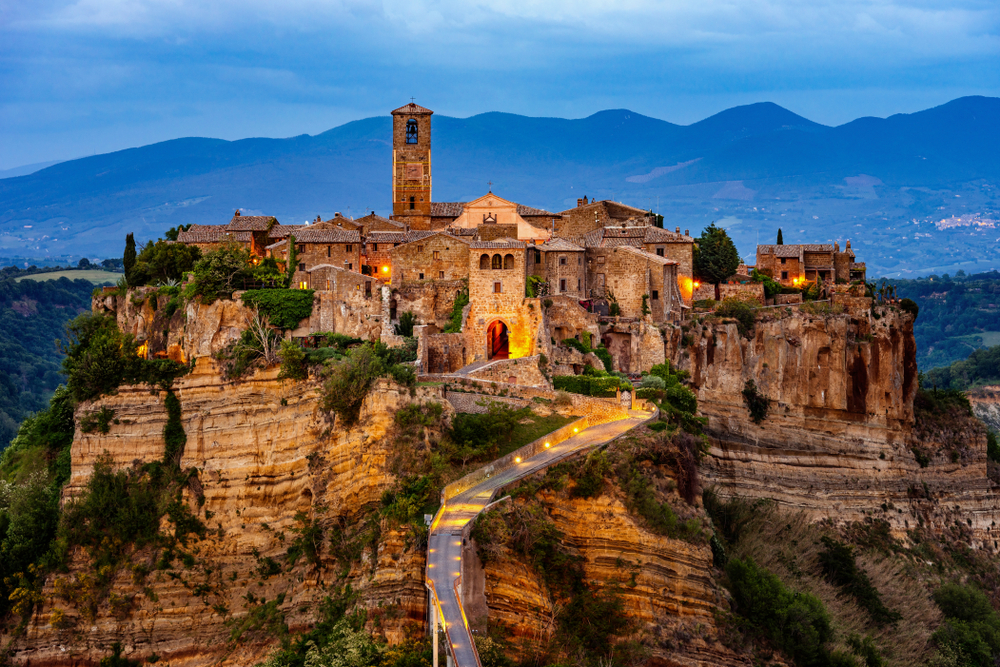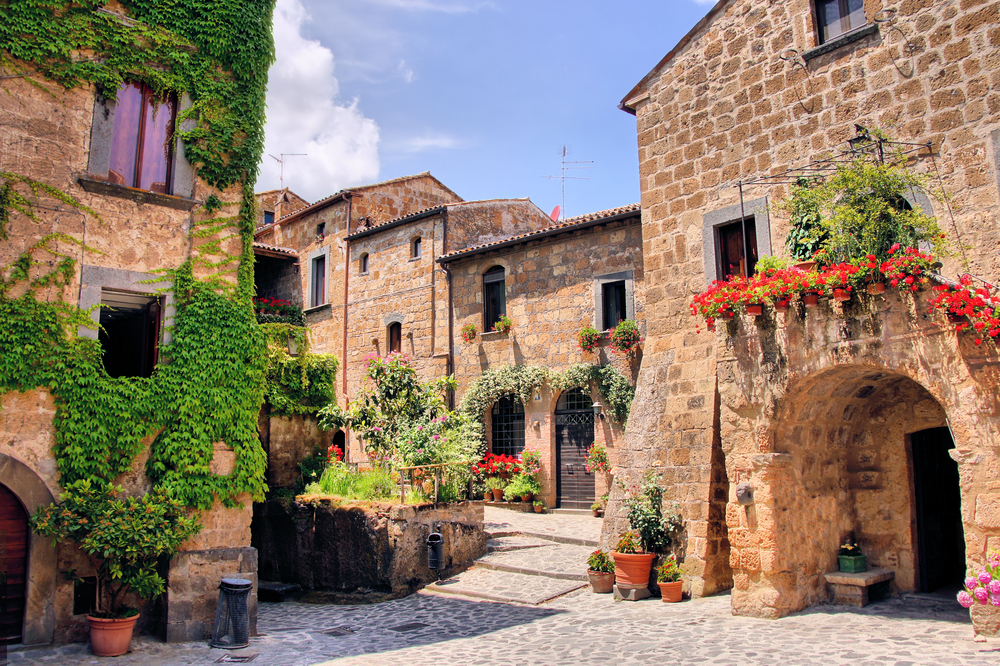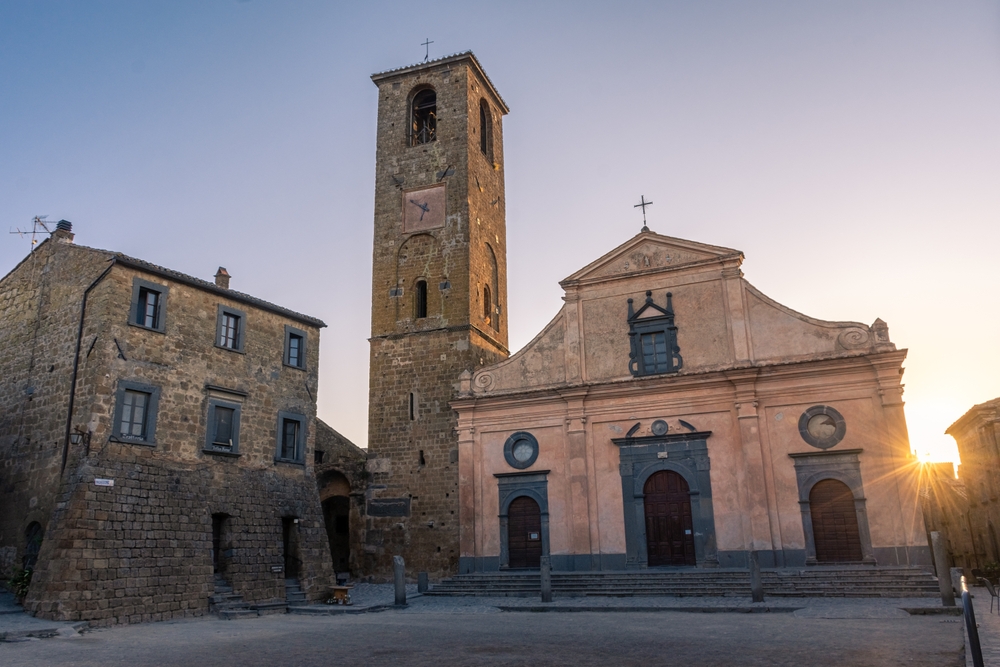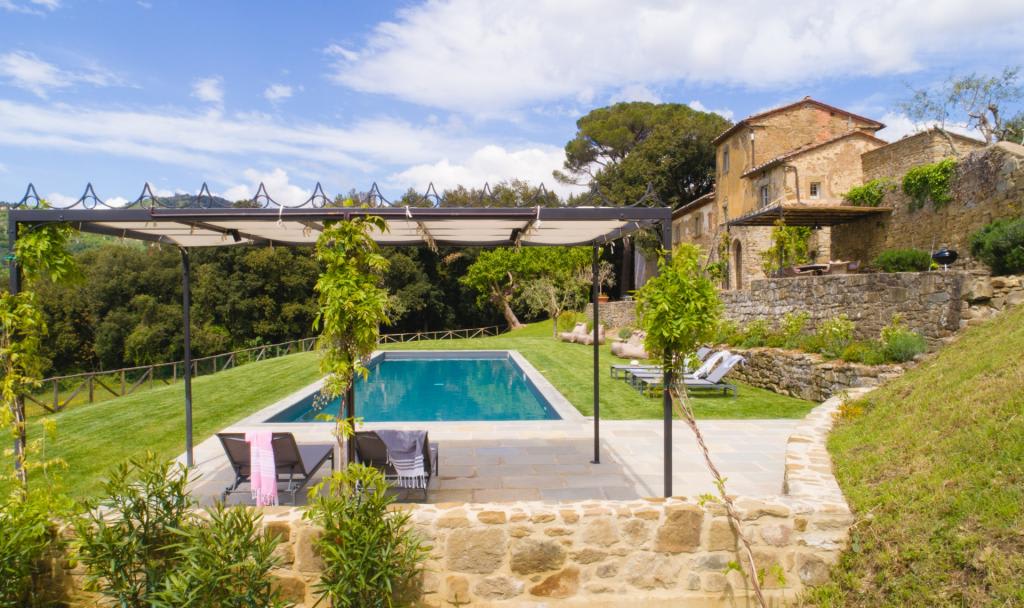Guide to Civita di Bagnoregio: Bagnoregio Travel Guide
Civita di Bagnoregio is a small hamlet, perched atop a rocky plateau and situated in the Lazio region of Italy, just over 50 miles north west of Rome. Civita used to be linked to the neighbouring town of Bagnoregio by a bridge but an earthquake in the 18th century divided the two. However, century by century, most of the residents moved from Civita to neighbouring Bagnoregio. The bridge linking the two was then partially destroyed in WWII by the Nazis as they fled. It was rebuilt in the 1960s but by then most of the residents had left or had been ordered out by the council due to extreme poverty.
These days, Civita di Bagnoregio has a year-round population of just a dozen people! In fact, the 20 cats that live here permanently outnumber the humans! It is surrounded on all sides by the Valley of Calanchi and sandwiched between two rivers – the Rio Chiaro and the Rio Torbido. Whilst the setting is stunning, it is also (quite literally) the downfall of Civita di Bagnoregio. The area has always been prone to earthquakes and the rocks on which it stands have been constantly subjected to erosion by both the rain, wind and nearby rivers.
The town has a long history and was inhabited by the Etruscans over 2500 years ago, perhaps not surprisingly given its strategic position and proximity to the mouth of the River Tiber. Ahead of their time, they were already well aware of the seismic instability of the area and they completed many projects to protect the village including drainage channels and river containment. However, unfortunately, their ancestors didn’t follow their lead and the village subsequently suffered significant erosion over the years. It is no surprise therefore that it has been known as Italy’s ‘dying town.’ Most recently, in 2014 and 2015, there were a series of landslides which saw some of the Medieval buildings of the village crash into the ravine below.

At least some positive action came out of this catastrophe though. These tragic events did result in a number of key Italian figures stepping up to protect Bagnoregio. The Italian composer, Ennio Morricone and the film director Bernardo Bertolucci, both signed a petition calling for Civita di Bagnoregio to be given UNESCO World Heritage status. And the Lazio regional government pledged funding to preserve this Italian gem.
Just as good came out of the tragic series of landslides in 2014 and 2015, much good came from Civita di Bagnoregio’s nickname as Italy’s ‘dying town’ too. These days, it has became a major tourist attraction!
The town itself can only be reached on foot via a concrete bridge and, ever since 2013, all visitors must pay an entrance fee – €3 on weekdays and €5 at weekends or on public holidays. The move to introduce this entrance fee coincided with a huge increase in visitor numbers – The village attracted 40,000 visitors in 2010, but twenty times this number a few years later. The entrance fee serves a dual purpose – it allows the authorities to monitor the flow of visitors but the revenue generated also allowed them to abolish the equivalent of the town’s council tax in both Civita and Bagnoregio (whose population stands at approximately 3500 people) whilst still improving services in the town and covering the costs of vital preservation work. The boom in tourism also led to increased employment amongst residents.
What to see and do in Bagnoregio
A visit to Bagnoregio truly is like stepping back in time. Cross over the 300 metre high suspension bridge and you will enter a Medieval world where it feels like time has stood still. We can highly recommend a private walking tour of Bagnoregio. Or opt for the cheaper downloadable audio guide and skip the line entry ticket for Bagnoregio.

Otherwise, if visiting on your own without a guide, start your visit at the Porta San Maria, a huge entrance gate. A carving of two human heads attacked by a pair of lions symbolises the despots defeated by the villagers hundreds of years ago. Move through the gateway and you will soon find yourself in the town’s main piazza. Here you will find a belltower and the 13th century Romanesque Church of San Donato which was renovated in the 16th century. This contains a number of superb Renaissance artworks including a fresco by the school of Perugino and a 15th wooden crucifix by the school of Donatello.
There is nothing more satisfying than simply wondering through the town’s narrow streets and alleyways lined with Medieval houses characterised by their small balconies and ladders. Look out for the Renaissance buildings of Colesanti, Alemanni and Bocca which stand out in comparison. Be aware as you walk that, under your feet, are ancient cellars, cisterns and tunnels, one of which dates back to pre-Roman times and was used as a bomb shelter in WWII.
Also make a point of visiting the Museum Antica Civitas and the grotto of San Bonaventure. Saint Bonaventure is the town’s most famous resident. Widely recognised as the second founder of the Franciscan order, the story goes that, when visiting Bagnoregio, St Francis cured a young boy called Giovanni di Fidenza, saving him from death. The boy’s mother made a promise there and then that when the boy grew up, he would serve God and so he did, becoming Friar Bonaventure of Bagnoregio.

Finally, before you leave, make a point of admiring the incredible views to be enjoyed from Bagnoregio, particularly from the east side where you can admire the ponticelli, which are massive clay walls and a visible sign of the erosion that has taken place here for thousands of years. And of course, the views from the bridge itself are incredible, stretching for miles in all directions across the Lazio region.
Events in Bagnoregio
The town’s main square is very much the focus of events in Bagnoregio. Visit in June and September and you will enjoy the spectacle of the donkey palio – the Palio del Tonno. It’s not dissimilar to Siena’s palio in some respects but the race course is far smaller and donkeys are ridden instead of horses. But otherwise it’s the same, with jockeys riding bareback three times around the track. Although, that said, only two compete at the same time as the track is so narrow that it’s not large enough for all participants to compete at once! It is highly entertaining – the donkeys are definitely not as well trained as Siena’s horses so expect them to just stop and graze midway round the course!
Alternatively, visit in December when you will find a living nativity taking place in Bagnoregio.
Where to stay in Bagnoregio
This Cortona villa rental is also a great base from which to explore Bagnoregio. Just 80 minutes drive from Bagnoregio, it’s an easy day trip. Sleeping up to eight guests in four beautifully presented bedrooms, it’s in an idyllic rural location but it’s possible to walk through the olive groves to reach the nearby village where there is a restaurant and pizzeria as well as village store and other amenities.

How to get to Bagnoregio
Bagnoregio is inaccessible to vehicles, with the exception of mopeds.
By air: The nearest airport to Bagnoregio is in Perugia approximately 80 km away. The journey time is around 70 minutes. Rome airport is just over 150 km from the village and is a 2 hour drive away.
By train: The nearest train stations to Bagnoregio are at Viterbo and Orvieto. Fron here, you can catch a COTRAL bus to take you to the village.
By car: If coming by car, you will need to pay to park your vehicle in the valley below the pedestrian bridge. From here you can walk to the beginning of the bridge that takes you across to Civita di Bagnoregio but we should warn you that it’s quite a steep uphill walk! Instead, you can always opt to take the free shuttle bus to the start of the bridge instead.


